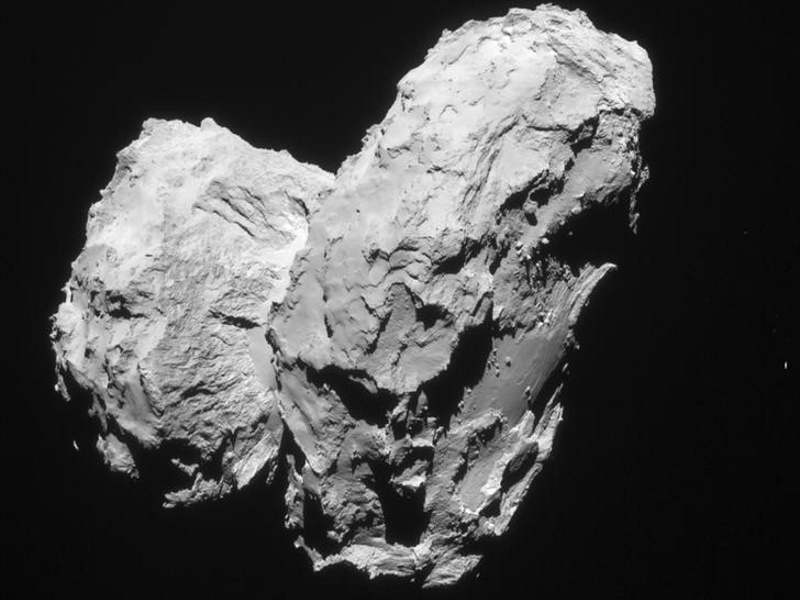- Home
- Science
- Science News
- Rosetta Spacecraft Finds Key Building Blocks for Life in a Comet
Rosetta Spacecraft Finds Key Building Blocks for Life in a Comet

The European Space Agency's Rosetta spacecraft made several detections of the amino acid glycine, used by living organisms to make proteins, in the cloud of gas and dust surrounding Comet 67P/Churyumov-Gerasimenko, scientists said on Friday.
Glycine previously was indirectly detected in samples returned to Earth in 2006 from another comet, Wild 2. But there were contamination issues with the samples, which landed in the Utah desert, that complicated the scientific analysis.
"Having found glycine in more than one comet shows that neither Wild 2 nor 67P are exceptions," said Rosetta scientist Kathrin Altwegg of the University of Bern in Switzerland, who led the research published in the journal Science Advances. The discovery implies that glycine is a common ingredient in regions of the universe where stars and planets have formed, Altwegg said.
"Amino acids are everywhere, and life could possibly also start in many places in the universe," Altwegg added.
Altwegg and colleagues also found phosphorus, a key elementin all living organisms, and other organic molecules in dustsurrounding comet 67P. It was the first time phosphorus was found around a comet. Scientists have long debated the circumstances around theorigin of life on Earth billions of years ago, including thehypothesis that comets and asteroids carrying organicmolecules crashed into the oceans on the Earth early in itshistory."Meteorites and now comets prove that Earth has been seeded with many critical biomolecules over its entire history," said University of Washington astronomer Donald Brownlee, who led Nasa's Stardust comet sample return mission.Scientists plan to use Rosetta to look for other complex organic compounds around the same comet.
"You need more than amino acids to form a living cell," Altwegg said. "It's the multitude of molecules which make up the ingredients for life." Rosetta is due to end its two-year mission at 67P by flying very close to the comet and then crash-land onto its surface this September.
67P is in an elliptical orbit that loops around the sun between the orbits of the planets Jupiter and Earth. The comet is heading back out toward Jupiter after reaching its closest approach to the sun last August.
© Thomson Reuters 2016
Get your daily dose of tech news, reviews, and insights, in under 80 characters on Gadgets 360 Turbo. Connect with fellow tech lovers on our Forum. Follow us on X, Facebook, WhatsApp, Threads and Google News for instant updates. Catch all the action on our YouTube channel.
Related Stories
- Samsung Galaxy Unpacked 2025
- ChatGPT
- Redmi Note 14 Pro+
- iPhone 16
- Apple Vision Pro
- Oneplus 12
- OnePlus Nord CE 3 Lite 5G
- iPhone 13
- Xiaomi 14 Pro
- Oppo Find N3
- Tecno Spark Go (2023)
- Realme V30
- Best Phones Under 25000
- Samsung Galaxy S24 Series
- Cryptocurrency
- iQoo 12
- Samsung Galaxy S24 Ultra
- Giottus
- Samsung Galaxy Z Flip 5
- Apple 'Scary Fast'
- Housefull 5
- GoPro Hero 12 Black Review
- Invincible Season 2
- JioGlass
- HD Ready TV
- Laptop Under 50000
- Smartwatch Under 10000
- Latest Mobile Phones
- Compare Phones
- Realme P4x 5G
- OnePlus Ace 6T
- OPPO A6x 5G
- Samsung Galaxy Z TriFold
- Poco F8 Ultra
- Poco F8 Pro
- Huawei Mate 80 RS Master Edition
- Huawei Mate 80 Pro Max
- Asus ProArt P16
- MacBook Pro 14-inch (M5, 2025)
- Poco Pad M1
- Poco Pad X1
- Just Corseca Skywatch Pro
- Honor Watch X5
- Acerpure Nitro Z Series 100-inch QLED TV
- Samsung 43 Inch LED Ultra HD (4K) Smart TV (UA43UE81AFULXL)
- Asus ROG Ally
- Nintendo Switch Lite
- Haier 1.6 Ton 5 Star Inverter Split AC (HSU19G-MZAID5BN-INV)
- Haier 1.6 Ton 5 Star Inverter Split AC (HSU19G-MZAIM5BN-INV)

















